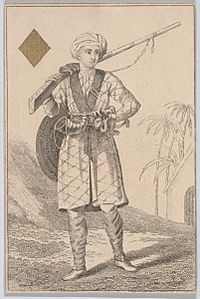Sepoy facts for kids
Quick facts for kids Sepoy |
|
|---|---|

Hyder Ali as a Sepoy
|
|
| Country | Mughal Empire British Raj India Pakistan |
| Branch | infantry and artillery |
| Equipment | Rifle |
A sepoy was a name for an Indian soldier, usually a foot soldier, who served in the armies of the East India Company or the British Indian Army. The word "sepoy" comes from the Persian language word "Sipahi." This term was used for soldiers from India, no matter their religion.
Today, the word "sepoy" is still used in some modern armies. For example, in the Indian Army, Pakistan Army, Bangladesh Army, and Nepalese Army, it means a private soldier. A private is the lowest rank for a soldier.
Contents
What Was a Sepoy?
A sepoy was an important part of military history in India. These soldiers were from India but often served under foreign command. They played a big role in many historical events.
Sepoys in History
The term "sepoy" became widely known during the time of the British Raj. This was when the British ruled parts of India. The British East India Company was a powerful trading company. It had its own army, made up mostly of Indian soldiers called sepoys. Later, the British government took over this army. It then became known as the British Indian Army.
The British East India Company
The East India Company was a British company. It started trading in India in the 1600s. Over time, it grew very powerful. It even started to control large areas of India. To protect its trade and territories, the company built a large army. Most of its soldiers were sepoys. These sepoys were trained and led by British officers.
Sepoys Today
Even though the British Raj ended, the word "sepoy" is still used. It is a respected term in several South Asian armies. It refers to a basic soldier, similar to a private in other armies around the world. This shows the long history and importance of these soldiers.
Images for kids
-
A Mughal sepoy, under the command of Mirza Najaf Khan.
-
The Mughal Emperor Aurangzeb leads his final expedition (1705), (sepoy column visible in the lower right).
-
An early 20th century sepoy in the British Indian Army, wearing a kurta.





